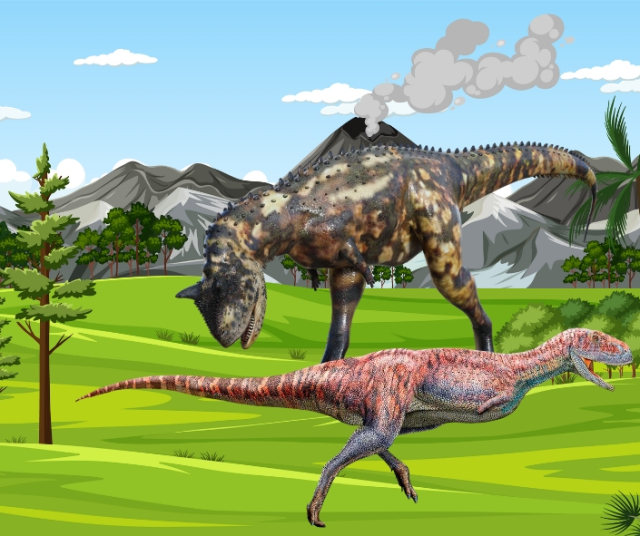Ecuador, known for its lush biodiversity and stunning landscapes, is also home to a fascinating prehistoric past, marked by the presence of towering dinosaurs. Although the fossil records of these ancient reptiles in Ecuador are more limited than in other regions of the world, the finds made to date provide valuable clues about the diversity and distribution of the dinosaurs that once inhabited this land.
Exploring the History of Dinosaurs in Ecuador.
The history of dinosaurs in Ecuador is a developing field within paleontology, with discoveries shedding light on the rich diversity of prehistoric life that once thrived in the region. Although fossil records of dinosaurs in Ecuador are less abundant compared to other places in the world, paleontologists have made important discoveries that help reconstruct the country's ancient past.
The first signs of the presence of dinosaurs in Ecuador date back to the 1960s, when the first fossil remains were discovered in the province of Loja, in the south of the country. Since then, paleontological expeditions have been carried out in various regions of Ecuador, including the Andes Mountains and the Amazon basin, which have led to the discovery of new and exciting finds.
One of the most important paleontological sites in Ecuador is the Chota site, located in the province of Imbabura, in the north of the country. This site has produced a variety of Cretaceous vertebrate fossils, including remains of dinosaurs, mammals, and other prehistoric animals. The finds at Chota have contributed significantly to our understanding of Cretaceous fauna in South America and have revealed the presence of unique species that once inhabited the region.
In addition to Chota, other sites in Ecuador have been of interest to paleontologists, including rock outcrops in Loja province and geological formations in the Napo basin of the Amazon. These sites have provided valuable fossils that shed light on the evolution and diversification of dinosaurs and other organisms during the Cretaceous period.
As paleontological research continues in Ecuador, it is expected that more exciting discoveries will be made that expand our understanding of the country's ancient history and its role in the evolution of life on Earth. Conservation and preservation efforts at paleontological sites are critical to protecting this invaluable heritage and allowing future generations to continue exploring and learning about the fascinating dinosaurs that once walked the Ecuadorian land.
The Dinosaurs that Walked the Ecuadorian Land.
During the Cretaceous period, Ecuador was a land full of life and diversity, home to a variety of dinosaurs that dominated the tropical landscapes and extensive wetlands that characterized the region at that time. Although dinosaur fossil records in Ecuador are less abundant than in other places in the world, discoveries made to date have revealed the presence of several groups of dinosaurs that contributed to the paleontological richness of the region.
Among the most notable dinosaurs that lived in Ecuador is the Carnotaurus. This carnivorous theropod, known for its short, deep skull as well as its small arms with sharp claws, was one of the dominant predators during the late Cretaceous in South America. Although no specific fossil remains of Carnotaurus have been found in Ecuador, it is believed that this dinosaur inhabited the region due to related discoveries made in neighboring countries such as Argentina and Brazil.
Another theropod believed to have lived in Ecuador is Abelisaur, a group of carnivorous dinosaurs that also lived in South America during the Cretaceous period. Abelisaurs were characterized by their short, robust skulls, as well as their reduced forelimbs. Although no specific remains of Abelisaurs have been found in Ecuador, their presence in neighboring countries suggests that they could also have inhabited this area and contributed to the food chain of the local ecosystem.
As for sauropods, a group of herbivorous dinosaurs known for their massive size and long necks, they are also believed to have been present in Ecuador during the Cretaceous. One of the most iconic sauropods that lived in South America is the Amargasaurus, known for the double spines that protruded from its neck. Although fossil records of Amargasaurus in Ecuador are scarce, it is likely that these giant herbivores inhabited the region, especially considering the diversity of their habitat during the Cretaceous.
In addition to these dinosaurs, other groups could also have left their mark on Ecuadorian territory during the Cretaceous. Hadrosaurs, or crested dinosaurs, are another group that may have lived in the region. These herbivorous dinosaurs were characterized by their serrated beaks and elaborate crests, which likely played a role in communication and recognition between individuals of the same species.
Titanosaurs, a subcategory of sauropods that includes some of the largest dinosaurs that ever lived, may also have lived in Ecuador. These giant herbivores were distinguished by their massive bodies and long necks, which allowed them to reach tall vegetation in the tropical forests that dominated the region during the Cretaceous.
Important Discoveries and Future Challenges.
Although dinosaur fossil records in Ecuador are limited, findings to date have provided valuable contributions to the study of paleontology in the region. Discoveries in the Santa Rosa Formation, a geological sequence located in the province of Loja, have shed light on the diversity of dinosaurs that once inhabited this area.
As paleontological research continues in Ecuador, it is likely that more fossil remains will be discovered that shed light on the ancient history of the region. However, the preservation of these valuable and fragile fossil remains faces challenges, such as deforestation, mining activity and urbanization, which threaten to destroy paleontological sites before they can be properly studied.
Although dinosaur fossil records in Ecuador are limited compared to other regions of the world, findings to date provide valuable clues about the diversity and distribution of dinosaurs that once inhabited this land. Continuing to research and protect these fossil remains is crucial to better understanding the prehistoric history of Ecuador and its place in the context of the evolution of life on Earth.
